Earlier this week, I asked you about your top nutrition questions – and I’ve spent hours poring over the survey responses.
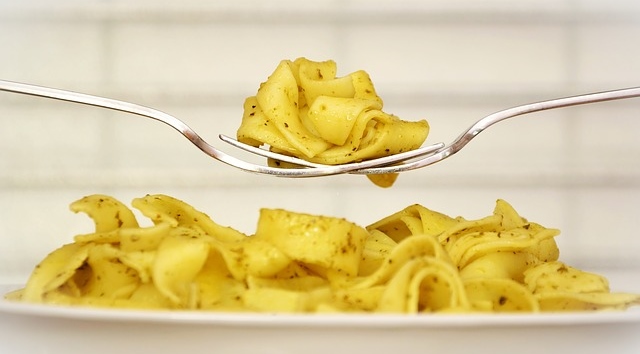
Let me tell you: your questions are fascinating. So many of us are struggling with different aspects of our diet. But don’t worry, there’s hope!
For over 6 months, I’ve been on a mission: to improve my nutrition and diet to maximize my running performances.
But more importantly, getting my diet needs right is about a lot MORE than just running faster.
I want to be fully present for my family.
I want to have the energy to create remarkable coaching material for you.
I want to recover faster, feel energized for most of my runs, and improve my mood.
And I’ve been working with a registered dietitian to create a program that will accomplish all of that, plus a lot more:
- Specific meal plans designed just for runners, showing you exactly what to eat and when
- The core principles that promote a healthy diet (with NO “dieting”)
- The workouts and training that can help you drop those last few pounds
- A cookbook of runner-friendly recipes that you can cook easily in a short amount of time
- A lot more…
My partner on this project is Anne Mauney, MPH, RD and we’re thrilled to unveil all of the details soon. We’re finalizing the program now, including a series of exclusive interviews with top sports nutritionists and coaches.
Now I want to discuss the darker side of the runner’s diet: the scary underbelly of nutrition “tips” that are keeping you above your goal weight, under-fueled (or OVER fueled!), and running without the nutrients that you need.
For almost a year, we’ve been researching this program. Asking questions like:
If running is such great exercise, why do some marathoners actually gain weight?
What specific foods and snacks are ideal for runners? And when should you eat them?
Why is it easy to lose some weight, but not the last 5-10 pounds?
Is it possible to create a diet program that’s EASY to follow, with no complex calculations?
Our goal is to design a program that answers these questions and provides a clear, simple path to health, faster running, improved recovery, and more energy.
Want to learn more about the program? Sign up here to learn more.
And as we spent months researching, asking questions, and interviewing some of the brightest nutrition experts in the country we discovered some glaring misconceptions about diet.
In fact, most of our diet mistakes are resulting in poor workout times, feelings of sluggishness, and the number on the scale being a little higher than we would like.
So it’s about damn time we finally set the record straight about what you should avoid to improve your diet.
Eating too many “health foods”
Labels don’t lie… right? Unfortunately, labels are meant to confuse you.
Billions of dollars are spent on marketing budgets and research for foods that aren’t really food – but they’re certainly sold as food!
In a world of 100-calorie snack packs, “light” versions of real foods, and Fiber Plus options, it’s a miracle that we can identify what the hell a real food even looks like.
Why do we eat so much food that doesn’t actually resemble food? It’s not helping us lose weight or improve our running. This study clearly showed that a high-nutrient diet can reduce hunger (even with fewer calories!) and improve your long-term health.
When I go to the grocery store, I’m on the lookout for certain keywords. If a food has these words on the label, I’m suspicious:
- heart-healthy (the US government was wrong about which foods are heart-healthy for 30 years)
- natural (WTF does that even mean?)
- sugar-free or fat-free (what else is being added to make up for having no sugar or fat?)
Most of these items are food products, not actually food. They’re designed in a lab – formulated to be a specific “bliss point” by manipulating sugar, fat, and mouthfeel to make them irresistible.
The major food companies spend ungodly amounts of money to determine the correct bliss point – and then to convince you it’s healthy.
In a startling exposé on modern food, the New York Times reports that:
Frito-Lay had a formidable research complex where nearly 500 chemists, psychologists and technicians conducted research that cost up to $30 million a year, and the science corps focused intense amounts of resources on questions of crunch, mouth feel and aroma for each of these items.
Their tools included a $40,000 device that simulated a chewing mouth to test and perfect the chips, discovering things like the perfect break point: people like a chip that snaps with about four pounds of pressure per square inch.
And it’s not just snack foods. It’s almost everything we eat, from cereal to yogurt:
[General Mills] Yoplait brand had transformed traditional unsweetened breakfast yogurt into a veritable dessert. It now had twice as much sugar per serving as General Mills’ marshmallow cereal Lucky Charms.
And yet, because of yogurt’s well-tended image as a wholesome snack, sales of Yoplait were soaring, with annual revenue topping $500 million. Emboldened by the success, the company’s development wing pushed even harder, inventing a Yoplait variation that came in a squeezable tube — perfect for kids. They called it Go-Gurt…
Modern food is not good for us. It’s not “real” – it’s food products specifically created to make our brains go wild with perfectly concocted salt, sugar, fat, and crunch levels.
Frankenfood, anyone?
Listening to “mainstream” diet advice
Be careful where you get your diet and nutrition advice. I’m in awe at what I’ve uncovered in the media over the last 6+ months of research.
The suggestions for what to eat, how to diet, and the best ways to lose weight are startling.
Like this gem, advising you to avoid chewing gum:
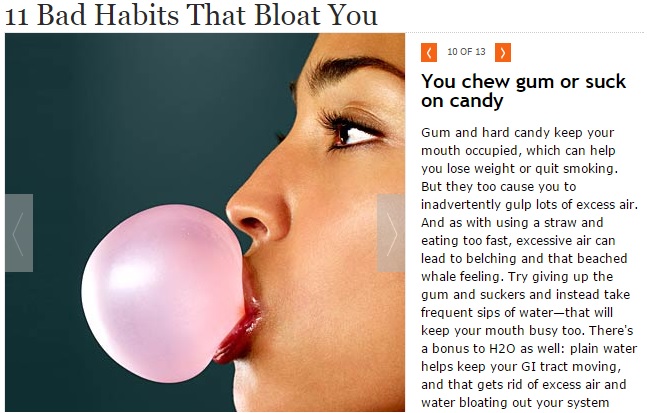 REALLY?! I only have so much energy during the day and worrying about chewing gum isn’t allowed to take up my valuable brain space.
REALLY?! I only have so much energy during the day and worrying about chewing gum isn’t allowed to take up my valuable brain space.
Next, we have a major running site telling you to drink breast milk. Seriously, I can’t make this stuff up:
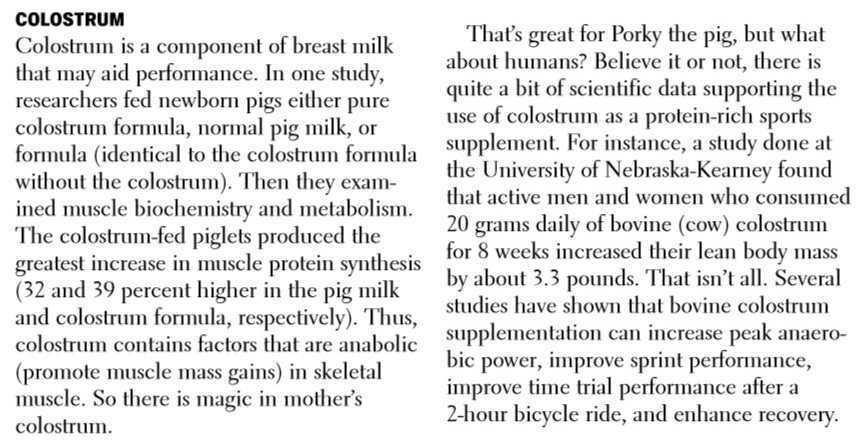
I’m literally laughing out loud right now, thinking of how I could get my hands on colostrum to improve my body composition.
Maybe the local butcher has some bovine colostrum on hand – and won’t call the men in white coats when I ask for a gallon of it this weekend…
We’ll end with this seemingly harmless example:
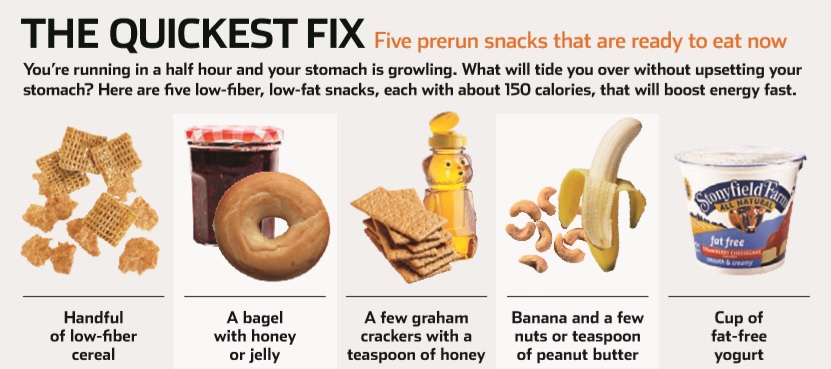
At first glance, these foods aren’t so bad… right? Unfortunately, they fall into the same trap we’ll discuss later: not being real foods.
Sure, the banana, cashews, and even cereal might be good for you. But a plain bagel and nonfat yogurt? Both have about as much sugar as a can of Coke!
Most of these foods aren’t ideal for maintaining energy levels throughout the day, proper fueling and giving your body the nutrients it needs to feel like the Incredible Hulk.
Runners are constantly exposed to these messages. We’re forced to believe the food products most common in stores are what we should eat.
But there are FAR better alternatives for runners who want to tweak their diet for maximum performance, weight loss, and energy.
Skipping breakfast… don’t do it!
Not eating breakfast is one of the most common mistakes that we found in our research.
We all intuitively know this, right? But interestingly, it’s one of those problems that we KNOW how to fix, but never do. And what’s more troublesome is that skipping breakfast is just the tip of the iceberg: more commonly, runners simply under-eat until lunch.
Even as we spoke to other dietitians with decades of experience, they admitted their clients would constantly under-fuel in the morning.
And it doesn’t matter if you run in the morning, during lunch, or in the evening. Fueling properly has real, tangible benefits:
- Feeling better – energized and unstoppable – during your workouts
- Recovering faster, with fewer sluggish days and higher energy
- More weight loss (yes, even as you eat more!) and improved body composition
- More energy after your runs so you’re not laid out after a long run
We’ve all heard that breakfast is the most important meal of the day, but recently this has come under fire, particularly among the Paleo and CrossFit crowd who also recommend occasional intermittent fasting.
Of course, every issue is nuanced: sometimes you should skip breakfast (we’ll go over this in more detail soon). But 95% of runners should eat breakfast every single day.
What most don’t realize is that the recommendations from those outside the world of running are not suitable for runners. Just like workouts must be specific, so must our nutrition.
A clear trend among the Registered Dietitians we interviewed was that eating breakfast and refueling properly after a morning run are critical not just for optimal performance, but for weight management.
And it’s not enough to scarf down a bagel. Runners can’t eat crappy food! We’re athletes. It’s about time we started eating like athletes. It might be difficult, but we have to get out of our comfort zones.
Nutrient dense foods that are also easy on the stomach are a runner’s best friend. These power foods give us the energy for our workouts and the building blocks to support a long, happy life.
Paleo? Not if you’re a runner
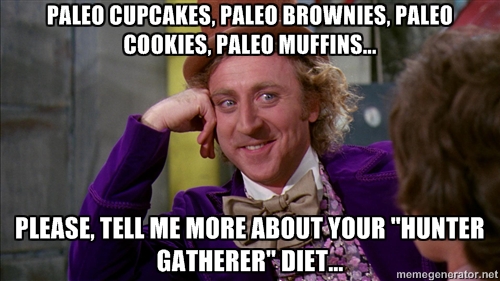
Oh, Paleo. I have a love-hate relationship with this diet.
I love that I can eat an enormous vegetable omelette with bacon and sausage. I love that I don’t have to count calories or weigh my food. I love how it’s relatively easy.
But I hate that it’s so restrictive, virtually eliminating an entire macronutrient! Who wants to live without carbohydrates? And more importantly, what runner can thrive on a diet that eliminates the best fuel choice?
The reality is that eating a low-carb diet, whether that’s Paleo, Atkins, Primal, Caveman, or whatever the kids today are calling it, isn’t smart for 99% of runners. And I’m not the only one who thinks so.
It’s simply not an ideal runner’s diet. It doesn’t provide the energy you need to run at your best. And without feeling your best, you’ll never train at a level high enough to attain your ideal body composition.
Sure, some ultramarathon runners may gradually adapt to and thrive from a Paleo diet. Unless you’re an ultra runner (50-100 miles), there’s almost no reason to eat Paleo.
Plus, there’s a host of other drawbacks:
- Time: prep takes forever when everything has to be chopped, cut, and cooked
- Budget: a diet made up entirely of fresh vegetables and a lot of meat is expensive
- Patience: adapting to running with a low carb intake takes at least a month
- Will: adapting to running with little carbohydrate isn’t fun – you’ll feel terrible for weeks
During our research for the Nutrition for Runners program, we discovered a clear trend among the registered dietitians and coaches we interviewed: not one recommended the Paleo diet.
And when I took the USA Track & Field coaching course, the class on nutrition clearly instructed us to be wary of low-carb diets. No Olympians or national champion runners are eating Paleo… so why should you?
Being too detail oriented
Any diet that makes it difficult to eat is not one that I want to follow. I’m sure you’re the same way.
But there are so many options available today, and many of them require you to…
- Count calories… I’d rather weave my own running clothes from dryer lint
- Weigh your food… taking a scale out at a restaurant is the new rage these days
- Calculate percentages of macronutrients… every single day
- Assign every food a score… who loves tests?!
Do you REALLY want to do all of this? I sure as hell don’t!
There are two main issues with this level of detail:
1. It’s simply not necessary. With every diet approach we researched, with every RD we interviewed, and with countless client success stories among runners, nobody ever counted, weighed, or scored their food.
If you’re the Type-A person who has the time and willpower to obsess over every detail, you might find success with this type of approach.
But if you’re a normal person who enjoys eating but doesn’t have the time (or willingness!) to go to these extremes, there’s good news: you don’t have to!
As Nancy Clark, MS, RD, CSSD, arguably the country’s top sports nutritionist, told us:
You don’t need to count calories. The body is the best calorie-counter.
2. It’s impossible to maintain. Dieters who go to the extremes of scoring their food or counting every calorie never stick with this approach because it’s inconvenient.
Measuring your intake of calories, expenditure of energy, and making a healthy diet so complex is a recipe for poor adherence to the diet, ultimately leading to failure.
Instead, keep it simple! Not only is it easier to stick with a particular way of eating, you won’t go crazy and you can focus on enjoying your food. Sounds good to me!
How to Finally Eat Right
Eating healthy and reaching our diet and weight goals doesn’t have to be so complicated. By focusing on the basics – with a proven plan to help you get there – you can elevate your running to new heights with more energy and faster recovery.
We’re busy putting the finishing touches on the Nutrition for Runners program and we’re SO excited for you to see it.
More details will be revealed soon to those of you on this email list, so make sure you sign up to learn more about the program.
You’ll find out about the experts we interviewed, the meal guides, shopping list, cookbook of runner-friendly recipes and more.
Until then, look at your own eating habits. Do you make any of these mistakes? How can you make better diet decisions?
By fine-tuning your nutrition and tweaking your diet, you’ll undoubtedly become a better runner: faster, happier, energized, and with fewer injuries.
Who’s excited about that?? I know I am! And I can’t wait to share it with those on the priority list here.